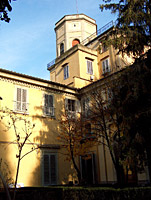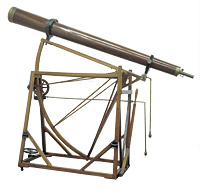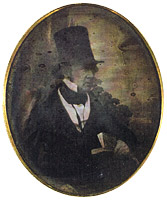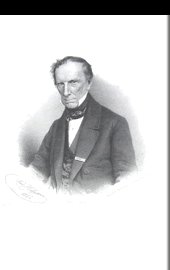A biography of Giovanni Battista Amici
1840-1845 - Refractor telescopes for Florence. Giovanni Battista Amici and William Henry Fox Talbot. On fertilization of plants -  return to index
return to index
At the Third Meeting of Italian Scientists, held in Florence in 1841, for which occasion the Galileo Tribune was inaugurated, Amici read Sopra un cannocchiale il cui uso si estende a tutti gli strumenti di Geodesia, and especially Intorno ad un telescopio acromatico di 16 piedi di distanza focale costrutto nelle officine dell’I. e R. Museo Fisico di Firenze (On a telescope whose use can be extended to all geodesic instruments; About a 16 foot focal distance achromatic telescope constructed in the workshops of the Physics Museum of Florence).
 This second presentation was of particular importance because in it he presented his large refractor with an aperture of about 11 inches (283 mm) and a focal distance of 16 feet (more than 5 m.) which he had constructed in the course of 1840. It was one of the larger achromatic telescopes of that time and it was called Amici I.
This second presentation was of particular importance because in it he presented his large refractor with an aperture of about 11 inches (283 mm) and a focal distance of 16 feet (more than 5 m.) which he had constructed in the course of 1840. It was one of the larger achromatic telescopes of that time and it was called Amici I.
In the summer of 1844, during his second trip to Paris and London, Amici bought two disks of flint glass of 11 inch diameter from Guinand, and from these he created his second 9 inch achromatic objective (238 mm with 3.18 m. of focal distance), called Amici II. The disks arrived in January, 1845.
Amici I, for which Giovanni Battista Donati had an equatorial mount made only in 1865, was to have been the principal instrument of the Observatory connected to the Museum. When Ernst Wilhelm Tempel arrived at the Arcetri Observatory in 1875 he found this telescope with a mahogany tube mounted parallactically in the great dome, and he used it for drawing the nebulae.The two objectives were still used in 1936 and 1952 for two solar eclipses.
 Amici read Notizia delle ricerche del Sig. Talbot per imprimere colla luce le immagini degli oggetti sopra la carta (News about Mr. Talbot’s research on imprinting by light images of objects onto paper) at the Ordinary Assembly of the Academy of the Georgofili in Florence on 13 February, 1842. His relationship with William Henry Fox Talbot dated back to the early 1820s when the English scientist read the report on catadioptric microscopes and decided he wanted to have one for himself. Talbot was in Modena in September of 1822 and again in March of 1826. The next year the two met in London, but meetings and correspondence were interrupted in 1827 and didn’t begin again until twelve years later when Amici had the circular and invitation for participation in the first Meeting of Italian Scientists sent to Talbot. The Meeting was to be held in Pisa in October, 1839. Talbot had long been researching how to fix images by means of light and, urged on by the announcement of Daguerre’s discovery, he decided to take advantage of the occasion to make his photogenic drawings known to the scientists in Pisa, who were both Italian and foreign. Unfortunately, the drawings didn’t arrive on time. Only in 1842, thanks to the intermediation of his half sisters Horatia and Caroline, who lived in Florence, did Talbot manage to get some examples of his work to Amici. By now they had become calotypes.
Amici read Notizia delle ricerche del Sig. Talbot per imprimere colla luce le immagini degli oggetti sopra la carta (News about Mr. Talbot’s research on imprinting by light images of objects onto paper) at the Ordinary Assembly of the Academy of the Georgofili in Florence on 13 February, 1842. His relationship with William Henry Fox Talbot dated back to the early 1820s when the English scientist read the report on catadioptric microscopes and decided he wanted to have one for himself. Talbot was in Modena in September of 1822 and again in March of 1826. The next year the two met in London, but meetings and correspondence were interrupted in 1827 and didn’t begin again until twelve years later when Amici had the circular and invitation for participation in the first Meeting of Italian Scientists sent to Talbot. The Meeting was to be held in Pisa in October, 1839. Talbot had long been researching how to fix images by means of light and, urged on by the announcement of Daguerre’s discovery, he decided to take advantage of the occasion to make his photogenic drawings known to the scientists in Pisa, who were both Italian and foreign. Unfortunately, the drawings didn’t arrive on time. Only in 1842, thanks to the intermediation of his half sisters Horatia and Caroline, who lived in Florence, did Talbot manage to get some examples of his work to Amici. By now they had become calotypes.
 The two scientists met one last time in London in 1844 during Amici’s second trip there. With a note dated 17 July of that year, Talbot gave him two newly-published copies of his book The pencil of nature, one for Amici, together with ten photographs, and one for the Grand Duke Leopold II. On 21 September, once returned to Italy, Amici took part in the Sixth Meeting of the Italian Scientists in Milan and there he was able to demonstrate the improvements which Talbot had obtained in photography, as well as the plates engraved by Fizeau from daguerreotype experiments.
The two scientists met one last time in London in 1844 during Amici’s second trip there. With a note dated 17 July of that year, Talbot gave him two newly-published copies of his book The pencil of nature, one for Amici, together with ten photographs, and one for the Grand Duke Leopold II. On 21 September, once returned to Italy, Amici took part in the Sixth Meeting of the Italian Scientists in Milan and there he was able to demonstrate the improvements which Talbot had obtained in photography, as well as the plates engraved by Fizeau from daguerreotype experiments.
Amici read the following papers at the Fourth Meeting in Padua in 1842: Sulla fecondazione delle piante (Cucurbita pepo), Osservazioni sugli zoospermi della Chara, and Nuove osservazioni sugli stomi del Cereus peruvianus (On the fertilization of plants < Cucurbita pepo >, Observations on zoosperms in the Chara, and New observations on the stomas of the Cereus peruvianus).
The German botanist Matthias Jacob Schleiden (1804-1881), professor at the University of Jena, had carried out a great deal of research on the structure of the ovule and the transformations which take place in it. He had wanted to discover the first formation of the embryo, but he lost his way. No one better than Amici, with his early research, could examine Schleiden’s ideas and oppose them if necessary. This he did in the Meeting in Padua in his presentation on the fertilization of the Cucurbita  Pepo, a plant he had been studying for years. Amici tried to prove that the embryo forms not in the pollen tube but in a part of the ovule which predates the fertilization, and that that part receives the fertilizing liquid from the pollen tubes. Hugo Mohl wrote that the demonstrations made against Schleiden’s theory were not really very convincing. The choice of the pumpkin was not the happiest for this task because research on the fertilization process is more difficult there than in other plants. What’s more, although Amici was perfectly convinced by his research that the embryo didn’t form in the pollen tubes, his presentation was not sufficient to explain where it actually forms. The presentation had the result of attracting a severe attack from Schleiden.
Pepo, a plant he had been studying for years. Amici tried to prove that the embryo forms not in the pollen tube but in a part of the ovule which predates the fertilization, and that that part receives the fertilizing liquid from the pollen tubes. Hugo Mohl wrote that the demonstrations made against Schleiden’s theory were not really very convincing. The choice of the pumpkin was not the happiest for this task because research on the fertilization process is more difficult there than in other plants. What’s more, although Amici was perfectly convinced by his research that the embryo didn’t form in the pollen tubes, his presentation was not sufficient to explain where it actually forms. The presentation had the result of attracting a severe attack from Schleiden.
Bibliography
H. von Mohl, Giambattista Amici, “Botanische Zeitung”, N. 51, 18. December 1863 (Italian translation by A. Meschiari, “Atti della Fondazione Giorgio Ronchi”, 2-1999); Giorgio Abetti, Amici, Giovanni Battista, “Enciclopedia Italiana”, Roma 1950, vol. II; Guglielmo Righini, Storia e vicende degli obbiettivi astronomici di G. B. Amici, “Physis”, XI-1969; A. Meschiari, Corrispondenza di Giovanni Battista Amici con William Henry Fox Talbot, “Nuncius”, 1-2003.
